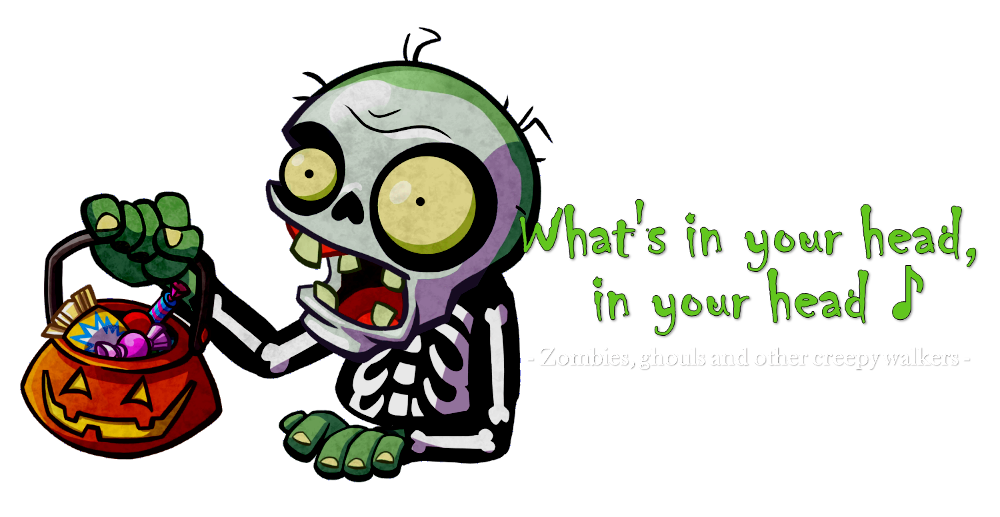What's in your head, in your head ♪ - Zombies, ghouls and other creepy walkers
Hey there, traveler!
Since Spooktober has officially begun, I thought it only fair to use this opportunity to shed some light on the oldest horror trope ever: zombies. Or to be more precise, the reoccurring theme of living dead creatures, as they are so common nearly every civilization has one version of the legend.
The basics are pretty simple – something or someone that by all logic should be dead and buried now walks among the simple folk, terrorizing brains and eating children, or the other way around. Legends of these beings are so widespread they have different subcategories to them based on how touchable they are and how easily they come back after their should-be-final departure.
The meatier (or to sound intellectual, corporeal) variants range from the previously discussed vampires to literal rotting corpses pushed around by angry or just really bored demons. In contrast to the ephemeral ghosts, these living dead mean more direct physical threat, and by extension, cause a different kind of spook. You don’t feel ominous when you imagine a walking corpse running after you, you feel panic and terror.
Among the earliest representation of the un-dead trope is the Icelandic legend of the draugr (oh, yeah, more Skyrim references). These Nordic zombies are sometimes called ‘aptrganga’ meaning ’again-walker’, and that sums them up quite well. They are hideous rotting bodies of slain warriors walking about in their crypts and guarding the treasures buried with them. As to what causes a person to turn into a draugr, sources wary. Some sagas claim improper burial (not laying the body down horizontally, instead putting it in a chair or an upright coffin) is the main reason these wretches cannot rest, while other myths say the dead person’s soul is the main factor. Bloodthirsty, greedy, scheming and generally unpleasant people are denied the tranquility of death and their bad traits keep them going even in death.
On the other side of the world, there are the ghouls. These are not really the deceased people coming back to life, more devious body-kidnapping demons that inhabit a corpse and use it for… well, evil things. Appearing in pre-Islamic Arabic myths, ghouls were demonic beings with a taste for human flesh, naturally dwelling in cemeteries or (on some account) the desert plains, preying on unwary travelers. However during the 18th century, the ghouls were incorporated into English literature and became known as a type of undead being with cannibalistic tendencies. This version of the original myth became so popular it spread into horror and fantasy genres and thus the modern ghoul was born.
Now, you may ask “Darr, why is that every other mythology post had a medical condition that could explain the origins, but you only talked about myths and literature until now.” Well, people returning from the dead as rotting corpses isn’t something that could have a medical explanation… or is it?
On one account, yes, it absolutely is – the titular zombie legend.
Zombies are creatures of Haitian and Louisiana voodoo, created by magical means by a bokor or witch. Some of you may guess from some earlier posts that I absolutely adore the voodoo culture and religion, and one reason for that is its interesting fascination with death. There is a whole subtype of loa’s (supernatural beings that serve as an emissary between men and the one God, Bondye), called the Ghédé Loa that govern the realm and aspects of death. There is the four aspects of the Baron (Samedi, Cimetière, La Croix, Kriminel), as the ruler of the ghédé loa, and his wife Maman Brigitte, but then there’s Ghede Nibo, the first man to ever die violently and patron to murdered individuals, probably killed by Baron Kriminel, Papa Ghede who waits at crossroads to take souls into the afterlife, and many more. With such a rich pantheon of death covering every aspect, it was almost impossible not to touch the concept of reanimation and necromancy.
It is believed that the bokor is an evil counterpart of the voodoo priests, who use magic to resurrect the dead into zombies and forces them to work on his plantations as slave labor. Now, I’m not saying this can be proved scientifically, but there is a likely explanation as to what was happening, and that is tetrodotoxin (TTX for short). TTX is a really potent Na-channel blocker, a toxic substance that inhibits the activation of excitable cells like muscles and brain, thus shutting down the entire body. Nowadays it’s used for medical research, where it inhibits certain sodium channels, allowing scientists to inspect and figure out the mechanism of how our nerves function. But should someone ingest it or inject it into someone else, it can create the perfect illusion of death with no brain function, no breathing and no muscle movement even as a reaction to pain. These poisoned victims appear dead to most people without specific knowledge, but with precise measurement the toxin eventually wears off. To an innocent bystander the whole process looks like someone who was clearly dead now walks and breathes again, if only acting less sharp because of the toxin’s brain blocking aftereffects. And a resurrected dead who can’t walk properly is the spitting image of a zombie, off to work until his/her death on the poisoner’s farm.
I hope you found this little insight interesting. I wish a really spooky October to you, and make sure to check back next week for another Halloween trope dissected to bits.
Cheers,
Dar






Comments
Post a Comment